Use of Underwater-Image Color to Determine Suspended-Sediment Concentrations Transported to Coastal Regions
Abstract
1. Introduction
2. Materials and Methods
2.1. Experimental Method
2.2. Analysis Method
3. Results
3.1. Turbidity vs. Sediment Concentration
3.2. Underwater-Image Color vs. Sediment Concentration
3.3. Comparison with Turbidity-Based Predictions
4. Discussion
5. Conclusions
Author Contributions
Funding
Institutional Review Board Statement
Informed Consent Statement
Data Availability Statement
Acknowledgments
Conflicts of Interest
References
- Lin, B.; Falconer, R.A. Numerical modelling of three-dimensional suspended sediment for estuarine and coastal waters. J. Hydraul. Res. 1996, 34, 435–456. [Google Scholar] [CrossRef]
- Shin, B.S.; Kim, K.H. Prediction of environmental change and mitigation plan for large scale reclamation. J. Korean Soc. Coast. Ocean Eng. 2010, 22, 95–100. [Google Scholar]
- Jeong, J.H.; Tac, D.H.; Lim, J.H.; Lee, D.I. Analysis and improvement for impact assessment of suspended solids diffusion by marine development projects. J. Korean Soc. Mar. Environ. Energy 2017, 20, 160–171. [Google Scholar] [CrossRef]
- Chiew, Y.-M.; Lai, J.-S.; Link, O. Experimental, Numerical and Field Approaches to Scour Research. Water 2020, 12, 1749. [Google Scholar] [CrossRef]
- Khan, M.A.; Sharma, N.; Pu, J.H.; Pandey, M.; Azamathulla, H. Experimental Observation of Turbulent Structure at Region Surrounding the Mid-Channel Braid Bar. Mar. Georesour. Geotechnol. 2022, 40, 448–461. [Google Scholar] [CrossRef]
- Kang, W.; Jang, E.K.; Yang, C.Y.; Julien, P.Y. Geospatial analysis and model development for specific degradation in South Korea using model tree data mining. Catena 2021, 200, 105142. [Google Scholar] [CrossRef]
- Kang, W.; Lee, K.; Jang, E.K. Evaluation and validation of estimated sediment yield and transport model developed with model tree technique. Appl. Sci. 2022, 12, 1119. [Google Scholar] [CrossRef]
- Yang, C.Y.; Kang, W.; Lee, J.H.; Julien, P.Y. Sediment regimes in South Korea. River Res. Appl. 2022, 38, 209–221. [Google Scholar] [CrossRef]
- Eisma, D. Suspended Matter in the Aquatic Environment; Springer Science & Business Media: Berlin, Germany, 2012. [Google Scholar]
- Wells, J.T. Distribution of Suspended Sediment in the Korea Strait and Southeastern Yellow Sea: Onset of Winter Monsoons. Mar. Geol. 1988, 83, 273–284. [Google Scholar] [CrossRef]
- Lin, H.; Yu, Q.; Wang, Y.; Gao, S. Identification, Extraction and Interpretation of Multi-Period Variations of Coastal Suspended Sediment Concentration Based on Unevenly Spaced Observations. Mar. Geol. 2022, 445, 106732. [Google Scholar] [CrossRef]
- Cai, L.; Chen, S.; Yan, X.; Bai, Y.; Bu, J. Study on High-Resolution Suspended Sediment Distribution under the Influence of Coastal Zone Engineering in the Yangtze River Mouth, China. Remote Sens. 2022, 14, 486. [Google Scholar] [CrossRef]
- Amoudry, L.O.; Souza, A.J. Deterministic coastal morphological and sediment transport modeling: A review and discussion. Rev. Geophys. 2011, 49, 1–21. [Google Scholar] [CrossRef]
- Lisit͡syn, A.P. Sedimentation in the World Ocean with Emphasis on the Nature, Distribution and Behavior of Marine Suspensions; Society of Economic Paleontologists and Mineralogists: Tulsa, OK, USA, 1972; Volume 17. [Google Scholar]
- Kravchishina, M.D.; Lisitsyn, A.P.; Klyuvitkin, A.A.; Novigatsky, A.N.; Politova, N.V.; Shevchenko, V.P. Suspended Particulate Matter as a Main Source and Proxy of the Sedimentation Processes. In Sedimentation Processes in the White Sea: The White Sea Environment Part II; Springer: Berlin/Heidelberg, Germany, 2018; pp. 13–48. [Google Scholar]
- White, T.E. Status of measurement techniques for coastal sediment transport. Coast. Eng. 1998, 35, 17–45. [Google Scholar] [CrossRef]
- Felix, D.; Albayrak, I.; Boes, R.M. Continuous Measurement of Suspended Sediment Concentration: Discussion of Four Techniques. Measurement 2016, 89, 44–47. [Google Scholar] [CrossRef]
- Siadatmousavi, S.M.; Jose, F.; Chen, Q.; Roberts, H.H. Comparison between Optical and Acoustical Estimation of Suspended Sediment Concentration: Field Study from a Muddy Coast. Ocean Eng. 2013, 72, 11–24. [Google Scholar] [CrossRef]
- Hatcher, A.; Hill, P.; Grant, J.; Macpherson, P. Spectral optical backscatter of sand in suspension: Effects of particle size, composition and colour. Mar. Geol. 2000, 168, 115–128. [Google Scholar] [CrossRef]
- Merten, G.H.; Capel, P.D.; Minella, J.P. Effects of suspended sediment concentration and grain size on three optical turbidity sensors. J. Soils Sediments 2014, 14, 1235–1241. [Google Scholar] [CrossRef]
- Sun, Z.L.; Jiao, J.G.; Huang, S.J.; Gao, Y.Y.; Ho, H.C.; Xu, D. Effects of suspended sediment on salinity measurements. IEEE J. Ocean. Eng. 2017, 43, 56–65. [Google Scholar] [CrossRef]
- Leigh, C.; Kandanaarachchi, S.; McGree, J.M.; Hyndman, R.J.; Alsibai, O.; Mengersen, K.; Peterson, E.E. Predicting sediment and nutrient concentrations from high-frequency water-quality data. PLoS ONE 2019, 14, e0215503. [Google Scholar] [CrossRef]
- Kang, W.; Lee, K.; Kim, J. Prediction of suspended sediment concentration based on the turbidity-concentration relationship determined via underwater image analysis. Appl. Sci. 2022, 12, 6125. [Google Scholar] [CrossRef]
- Pu, J.; Wei, J.; Huang, Y. Velocity Distribution and 3D Turbulence Characteristic Analysis for Flow over Water-Worked Rough Bed. Water 2017, 9, 668. [Google Scholar] [CrossRef]
- Pu, J.H. Velocity Profile and Turbulence Structure Measurement Corrections for Sediment Transport-Induced Water-Worked Bed. Fluids 2021, 6, 86. [Google Scholar] [CrossRef]
- Minella, J.P.G.; Merten, G.H.; Reichert, J.M.; Clarke, R.T. Estimating Suspended Sediment Concentrations from Turbidity Measurements and the Calibration Problem. Hydrol. Process 2008, 22, 1819–1830. [Google Scholar] [CrossRef]
- Lawler, D.M.; Petts, G.E.; Foster, I.D.L.; Harper, S. Turbidity Dynamics during Spring Storm Events in an Urban Headwater River System: The Upper Tame, West Midlands, UK. Sci. Total Environ. 2006, 360, 109–126. [Google Scholar] [CrossRef] [PubMed]
- Bowers, D.G. Optical Techniques in Studying Suspended Sediments, Turbulence and Mixing in Marine Environments. In Subsea Optics and Imaging; Elsevier: Amsterdam, The Netherlands, 2013; pp. 213–240. ISBN 9780857093417. [Google Scholar]
- Gartner, J.W.; Cheng, R.T.; Wang, P.-F.; Richter, K. Laboratory and Field Evaluations of the LISST-100 Instrument for Suspended Particle Size Determinations. Mar. Geol. 2001, 175, 199–219. [Google Scholar] [CrossRef]
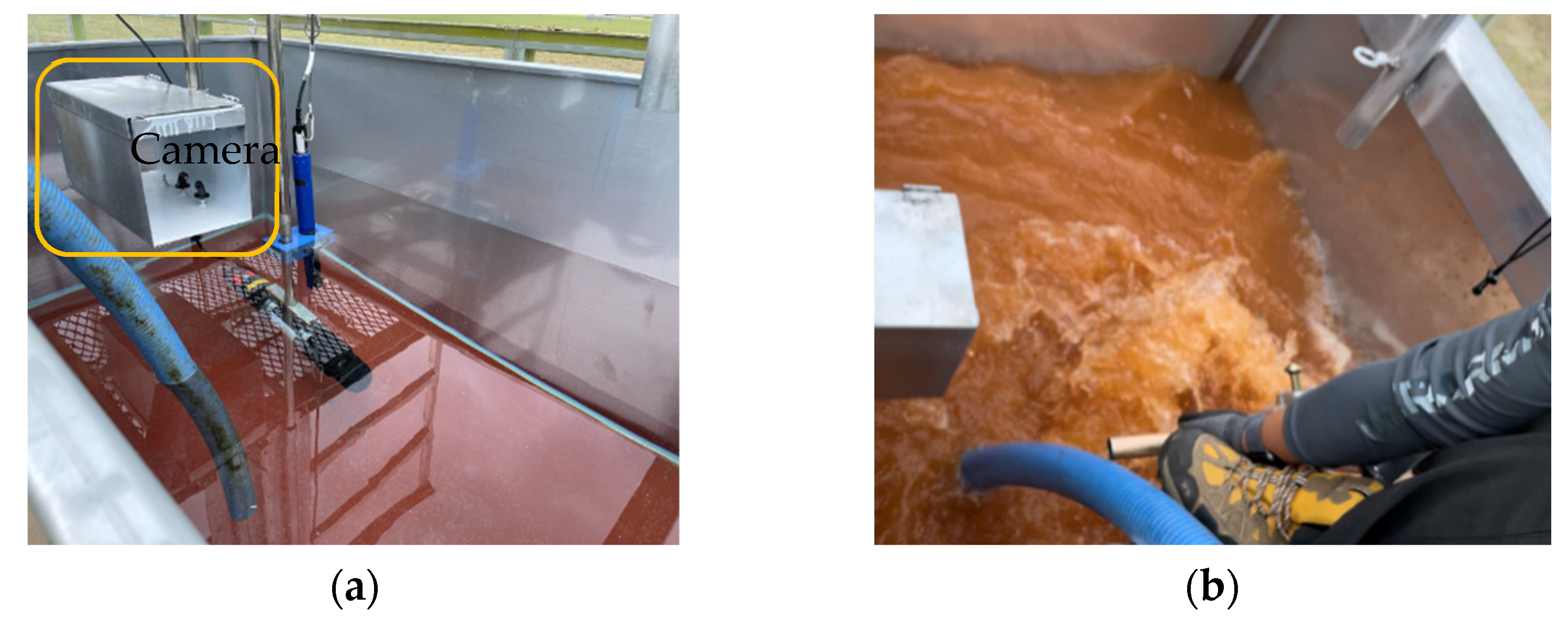
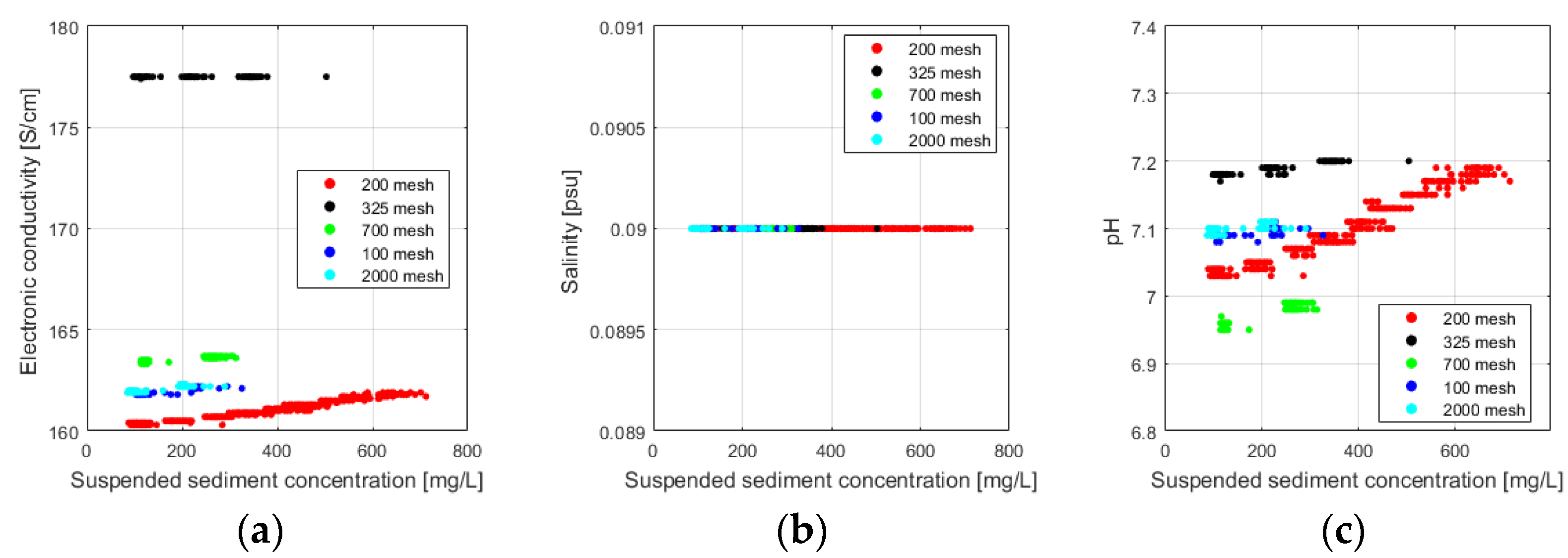
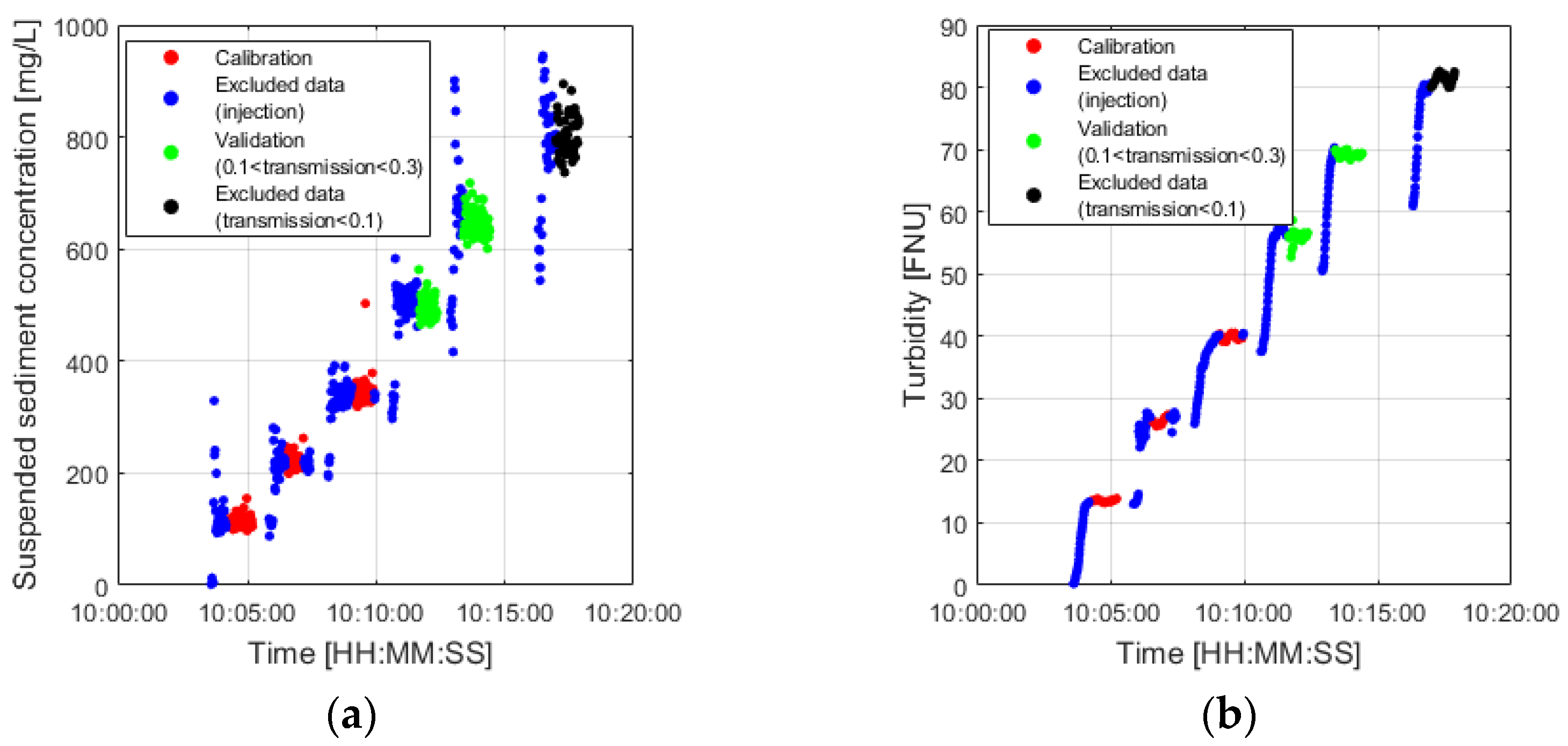
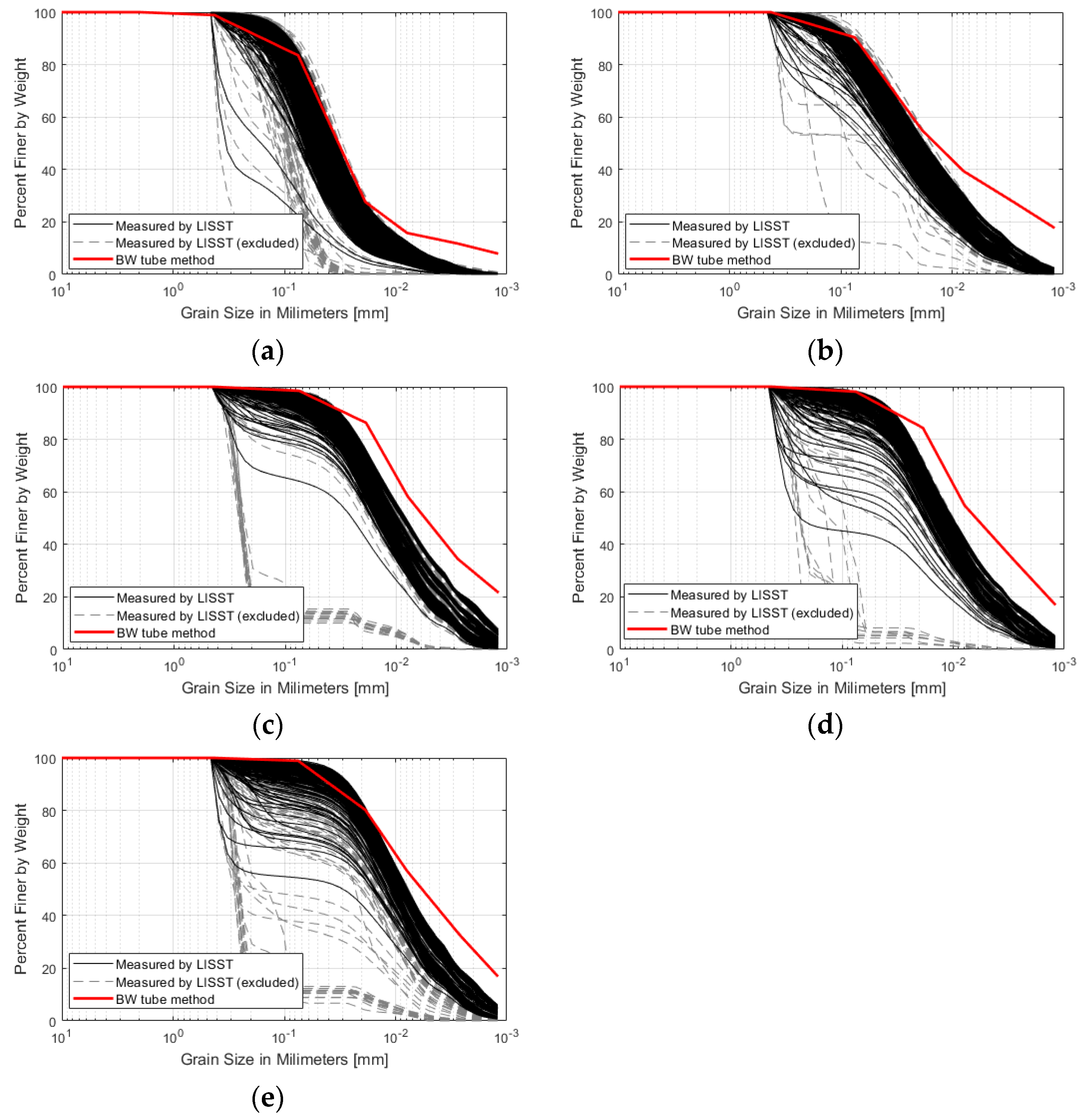

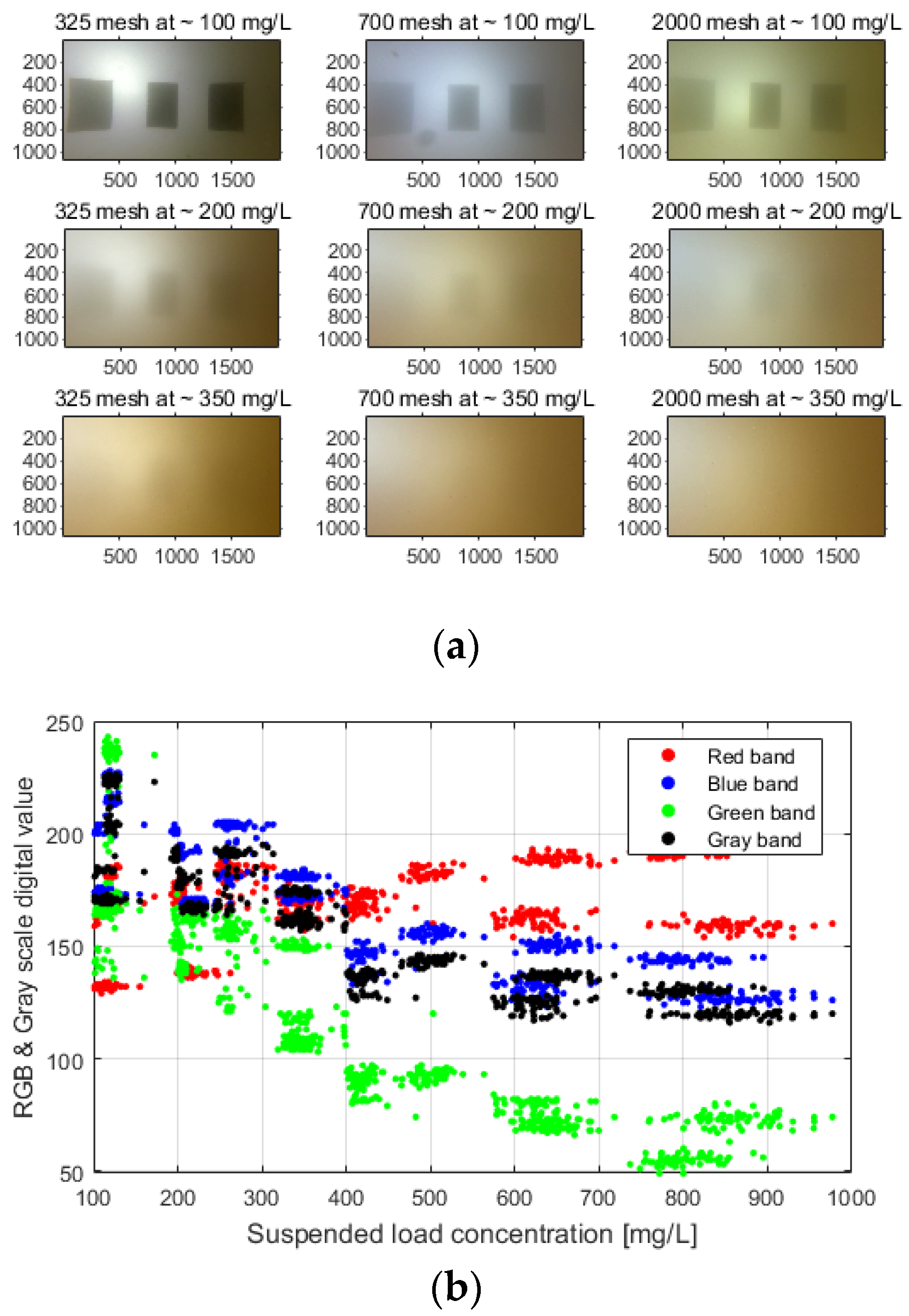
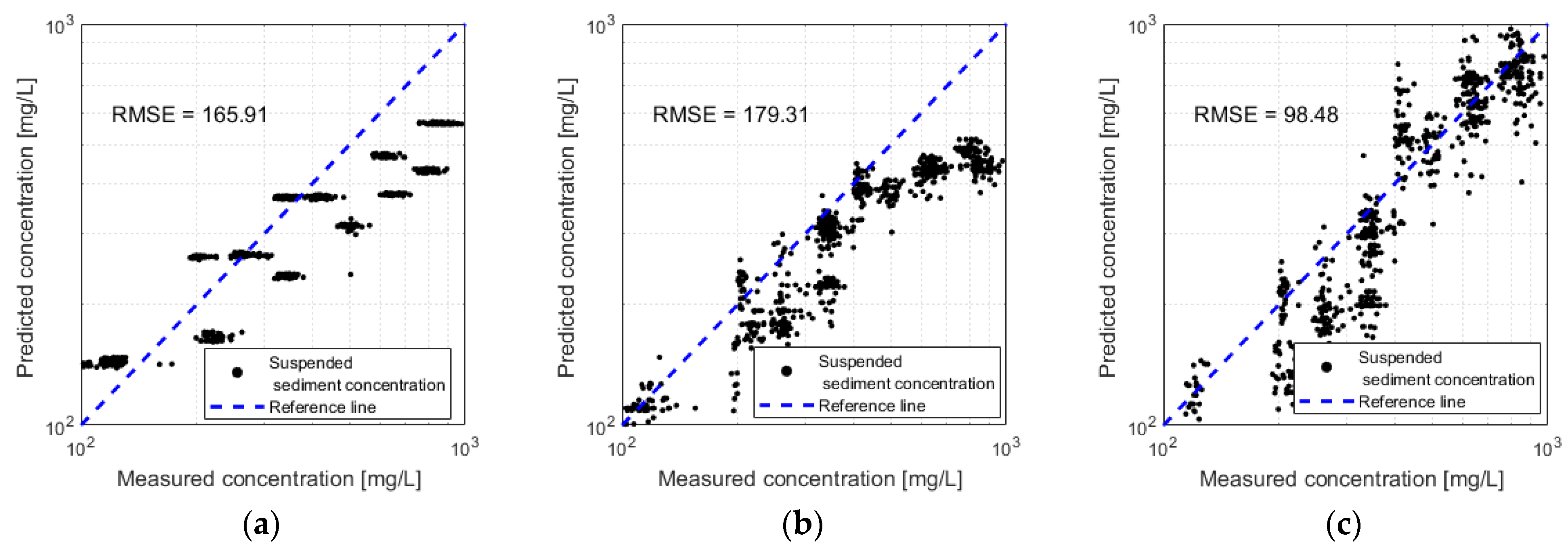
| Type | Equation | R2 |
|---|---|---|
| Power law | 0.66 | |
| Second-order polynomial | 0.61 | |
| First-order polynomial | 0.63 |
| Equation | R2 | Highest VIF |
|---|---|---|
| 0.82 | 102.16 | |
| 0.81 | 9.54 | |
| 0.80 | 1.11 | |
| 0.67 | 1.16 | |
| 0.68 | 1.99 |
| Equation | R2 | Highest VIF |
|---|---|---|
| 0.82 | 250 | |
| 0.73 | 8.89 | |
| 0.72 | 1.11 | |
| 0.62 | 1.12 | |
| 0.63 | 2.13 |
Disclaimer/Publisher’s Note: The statements, opinions and data contained in all publications are solely those of the individual author(s) and contributor(s) and not of MDPI and/or the editor(s). MDPI and/or the editor(s) disclaim responsibility for any injury to people or property resulting from any ideas, methods, instructions or products referred to in the content. |
© 2023 by the authors. Licensee MDPI, Basel, Switzerland. This article is an open access article distributed under the terms and conditions of the Creative Commons Attribution (CC BY) license (https://creativecommons.org/licenses/by/4.0/).
Share and Cite
Kang, W.; Lee, K.; Kim, S. Use of Underwater-Image Color to Determine Suspended-Sediment Concentrations Transported to Coastal Regions. Appl. Sci. 2023, 13, 7219. https://doi.org/10.3390/app13127219
Kang W, Lee K, Kim S. Use of Underwater-Image Color to Determine Suspended-Sediment Concentrations Transported to Coastal Regions. Applied Sciences. 2023; 13(12):7219. https://doi.org/10.3390/app13127219
Chicago/Turabian StyleKang, Woochul, Kyungsu Lee, and Seongyun Kim. 2023. "Use of Underwater-Image Color to Determine Suspended-Sediment Concentrations Transported to Coastal Regions" Applied Sciences 13, no. 12: 7219. https://doi.org/10.3390/app13127219
APA StyleKang, W., Lee, K., & Kim, S. (2023). Use of Underwater-Image Color to Determine Suspended-Sediment Concentrations Transported to Coastal Regions. Applied Sciences, 13(12), 7219. https://doi.org/10.3390/app13127219






